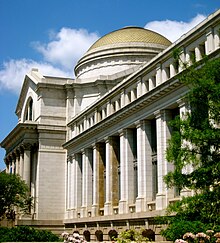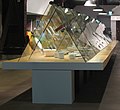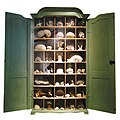Portal:Museums
The Museums Portal
A museum (/mjuːˈziːəm/ mew-ZEE-əm) is an institution dedicated to displaying and/or preserving culturally significant objects. Many museums have exhibitions of these objects on public display, and some have private collections that are used by researchers and specialists. Compared to a library, a museum hosts a much wider range of objects and usually focus around a specific theme such as the arts, science, natural history, local history, and other topics. Public museums that host exhibitions and interactive demonstrations are often considered to be tourist attractions, and many museums attract large numbers of visitors from outside their host country, with the most visited museums in the world regularly attracting millions of visitors annually.
Since the establishment of the earliest known museum in ancient times, museums have been associated with academia and the preservation of rare items. Museums originated as private collections of interesting items, and not until much later did the emphasis on educating the public take root. (Full article...)
Selected museum
The National Museum of Natural History (NMNH) is a natural history museum administered by the Smithsonian Institution, located on the National Mall in Washington, D.C., United States. It has free admission and is open 364 days a year. With 4.4 million visitors in 2023, it was the most-visited museum in the United States.
Opened in 1910, the museum on the National Mall was one of the first Smithsonian buildings constructed exclusively to hold the national collections and research facilities. The main building has an overall area of 1.5 million square feet (140,000 m2) with 325,000 square feet (30,200 m2) of exhibition and public space and houses over 1,000 employees.
The museum's collections contain over 146 million specimens of plants, animals, fossils, minerals, rocks, meteorites, human remains, and human cultural artifacts, the largest natural history collection in the world. It is also home to about 185 professional natural history scientists—the largest group of scientists dedicated to the study of natural and cultural history in the world. (Full article...)
Selected interior image
Selected general article

Heritage science is the interdisciplinary domain of scientific study of cultural and natural heritage. Heritage science draws on diverse humanities, sciences and engineering disciplines. It focuses on enhancing the understanding, care and sustainable use of heritage so it can enrich people's lives, both today and in the future. Heritage science is an umbrella term encompassing all forms of scientific enquiry into human works and the combined works of nature and humans, of value to people.
The above definition was developed though a community consultation organised by ICCROM and the European Research Infrastructure for Heritage Science in 2019. (Full article...)
Did you know...
- ... that the Paul Delvaux Museum exhibits not only Paul Delvaux's paintings, but also a collection of model trains?
- ... that One Night with Regine was a concert in support of the child-welfare program Bantay Bata, staged on the steps of the entrance façade of the National Museum of Anthropology in Manila?
- ... that King Mohammed VI of Morocco donated part of his royal collection to the new National Jewellery Museum?
- ... that after one of Piet Mondrian's paintings (shown) was discovered to have been hanging upside down for decades, the museum left it as is?
- ... that Max Creutz, director of the Kaiser Wilhelm Museum in Krefeld from 1922, acquired modern art including a painting by Max Ernst and a large collection of Bauhaus creations?
- ... that the Museum of Contemporary Art Australia is the only contemporary art museum in the country with a permanent collection?
Get involved
For editor resources and to collaborate with other editors on improving Wikipedia's Museums-related articles, see WikiProject Museums.
Selected exterior image
Selected type of museum

A virtual museum is a digital entity that draws on the characteristics of a museum, in order to complement, enhance, or augment the museum experience through personalization, interactivity, and richness of content. Virtual museums can perform as the digital footprint of a physical museum, or can act independently, while maintaining the authoritative status as bestowed by the International Council of Museums (ICOM) in its definition of a museum. In tandem with the ICOM mission of a physical museum, the virtual museum is also committed to public access; to both the knowledge systems embedded in the collections and the systematic, and coherent organization of their display, as well as to their long-term preservation. As with a traditional museum, a virtual museum can be designed around specific objects (such as an art museum or a natural history museum), or can consist of online exhibitions created from primary or secondary resources (as, for example in a science museum). Moreover, a virtual museum can refer to the mobile or World Wide Web offerings of traditional museums (e.g., displaying digital representations of its collections or exhibits); or can be born digital content such as, 3D environments, net art, virtual reality and digital art. Often, discussed in conjunction with other cultural institutions, a museum by definition, is essentially separate from its sister institutions such as a library or an archive. Virtual museums are usually, but not exclusively delivered electronically when they are denoted as online museums, hypermuseum, digital museum, cybermuseums or web museums. (Full article...)
Subcategories
Subtopics
Lists
- Museums
- Most visited museums (by region)
- Art museums: most visited, largest
Types
- Art museum
- Agricultural museum
- Archaeology museum
- Architecture museum
- Artillery museum
- Aviation museum
- Biographical museum
- Cabinet of curiosities
- Ceramics museum
- Children's museum
- Community museum
- Computer museum
- Design museum
- Dime museum
- Ecomuseum
- Economuseum
- Ethnographic village
- Farm museum
- Fashion museum
- Folk museum
- Food museum
- Green museum
- Hair museum
- Hall of Memory
- Heritage centre
- Historic house museum
- Human rights museum
- Imaginarium
- Interpretation centre
- Jewish museum
- Lapidarium
- Lighthouse museum
- Living museum
- Local museum
- Maritime museum
- Migration museum
- Mobile museum
- Museum ship
- National history museum
- Natural history museum
- Open-air museum
- Palace museum
- Postal museum
- Prefectural museum
- Print room
- Private museum
- Regimental museum
- Schatzkammer
- Science fiction libraries and museums
- Science museum
- Sex museum
- Sculpture garden
- Technology museum
- Textile museum
- Torture museum
- Toy museum
- Transport museum (list)
- University museum
- Virtual museum
- Wax museum
- Writer's home
Related
Associated Wikimedia
The following Wikimedia Foundation sister projects provide more on this subject:
-
Commons
Free media repository -
Wikibooks
Free textbooks and manuals -
Wikidata
Free knowledge base -
Wikinews
Free-content news -
Wikiquote
Collection of quotations -
Wikisource
Free-content library -
Wikiversity
Free learning tools -
Wiktionary
Dictionary and thesaurus







































































